Illicit Form of Meditation
20 / 10 / - 20 / 11 / 2000
Exhibition / Talk
Gordon Matta-Clark (USA 1943 - 78)
Rodney Graham (C *1949)
Constanze Ruhm (A *1949)
Talk by Constanze Ruhm
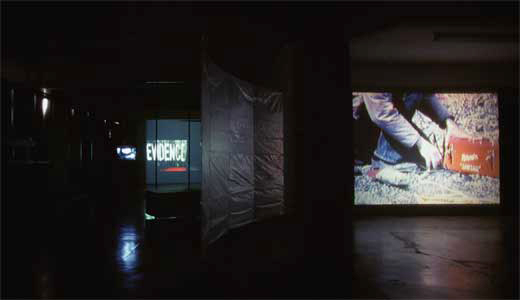
2nd floor installation view
"I think voyeurism
is a good space to drop in on from time to time. Only I haven't done much
lately because it takes tremendous devotion and patience. But like a ready-made
one works to fill in the blanks, the uncompleted silent actions framed in
windows. It needs constant attention, like an illicit form of meditation.
Good eyesight. Keen sense of change... Well, you know, you have to choose
the right place at the right time or it's all over."
Gordon Matta-Clark, Interview 1974
"Illicit Form of Meditation" introduces within the exhibition space, three narratives provided by three time based media works: Splitting (1973) Gordon Matta-Clark; Halcion Sleep (1994), Rodney Graham; and "Evidence" (2000), Constanze Ruhm. The project considers these artworks as 'meditations' in the sense referred to by Matta Clark's quote, to note how these silent works develop media's visual priviledge of the gaze as a way of facilitating a form of license that allows a view onto everyday social structures, architectures, shared imagery or recollection, that conveys how a sense of familiarity reveals at the same moment the potential of it as an uncanny construct.
The phrase, "Illicit Form of Meditation" contains in itself a notion of opposing forces drawn into different directions. 'Illicit' always suggests a break of a conventional rule, a taboo perhaps, a conscious act of transgression of limits imposed by the social contract which always involves some other. 'Meditation' speaks of contemplation, of immersion, of the possibility not of transgressing, but of dispatching oneself from the actual context.
Whether the physical act of splitting apart a conventional architectural structure, or in form of a drug-induced, thus artificial sleep which borders on the unconscious, or as an unsettling journey through a landscape which could be a flash of memory, or part of a dream inside of an unknown form of half-consciousness, there exists the suggestion of a movement towards an unresolved moment of trauma which is set in motion by physical, psychological and recollective motions of the artists minds. These artworks entail inscriptions joining narrative and media format together in one vexed identity, such that all focus on the transformation of the the media topos to that of the unconscious and imaginary ever more bound and associated through the screen.
Each artist's own stated engagment in examining the syntax that communicates everyday structures, develops the familiar structures of a contemporary present tense 'everyday', from a narrative informed and shaped by the '70s structuralist response to a Modernist romanticism, the psychoanalytic media deconstructions that developed in response to the new media screen ideology of the late '80s, postmodernism, and the convergence through the computer of different scripts and an internetted social imaginary within the information age.
By drawing specific lines out from these methodological enquiries and tracing them upon the institutional plan, haus.0 continues its reflection on a program identity in another "Illicit Form of Meditation". The notion of the 'rooms' architecture's solid character is no longer able to be split or revealed, rather it is turned and folded upon itself as site, institutional and exhibition space, to reveal familiar schemas and memories enabled by computer wireframes, signal ratios, links, plotted camera paths, and projective overlay.
Gordon Matta Clark
Splitting (1973)
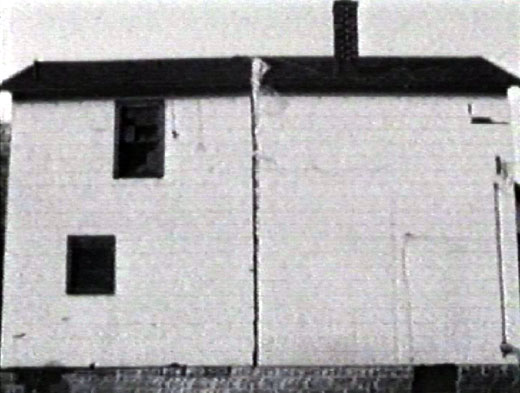
Still from Splitting (1973) Gordon Matta Clark
The artist Gordon Matta Clark's work Splitting, (1973) examines
what constitutes the entity 'house' by dividing the literal one into two.
In turn, the architectural container is seperated from its social unity,
an act of revealing set up as much of Matta Clark's work, in the spectacle
of a performative act. The architectural intervention as a narrative, is
documented as a performative act on film. The final result, here on video,
is charged by the sense of 'revealing' an interior within a visual format.
The work of media is present in the attention to the narrative itself, the
intertitles, the similarity to the silent films as well as science documentary.
Perhaps today most striking to the film, is the only word appearing outside
of titleboxes, is the image showing the box that holds the important cutting
tool, whose brand is "sawzall", an english pun that joins the
act of 'sawing' and 'to see'..all.
Gordon Matta Clark
Interview 1974 (excerpts)
"...The things we studied always involved such surface formalism that I had never a sense of the ambiguity of a structure, the ambiguity of a place, and that's the quality I'm interested in generating in what I do. To some degree that's the aspect I think of as sculptural, a vigorous transformation process that starts to redefine the given. In the case of the Humphrey Street building it was cutting."

Book edition, Gordon Matta-Clark, Wallpaper, Buffalo Press (1973)
on display as part of haus.0 Print Plug-In
"I'm dealing with architectural structure as a reality. I mean, there's something about the house which is very substantial, especially in terms of the environment in which it exists ... It's like juggling with syntax, or disintegrating some kind of established sequence of parts. In this particular case, the piece is a way of imposing a presence, an idea; it's a way to disorientation by using a clear and given system..."
"[I'm] dealing with the building as a clear, recognizable object, and distortions of that object as a direct train of thought in which the building's structure provides the vocabulary. If it weren't recognizable, it would be hard to use it."
Rodney Graham
Halcion Sleep (1994)
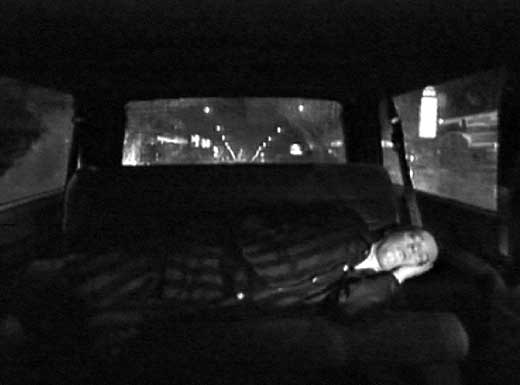
Videostill, Halcion Sleep, (1994)
Excerpts from the artist's writing "Siting Vexation Island", from Island Thought, published on the occasion of Graham's work representing the Canadian Pavilion, 48th Venice Biennale.
"Recollection long ago led me to the discovery of a personal substratum of screen memories: those include James Stewart at the prison whipping-post in Carbine Williams, Stewart Granger's narrow escape from impalement by a falling chandelier in Scaramouche, snakes and insects extracted from a black puddle and eaten by the starving explorers in Northwest Passage, the empty spotlight in The Red Shoes, the puppets in Lili. The list is finite because these beautiful if tawdry cinematic recollections date from my fourth year when I lived with my family in a logging camp in British Columbia where my father was a camp-manager, cook (during a strike of the catering crew) and projectionist. The latter function he filled only on Sundays, when films were shown in the cookhouse. I attended these screenings and thus, as Robert Linsley has reminded me, remained in close proximity not only to patriarchal authority but also to the cinematic apparatus itself."
(...)"I had intended to document my performance work Halcion Sleep (1994) in film but this proved impractical and, finally, inappropriate. In the end, it took the form of a continuos 26 minute single-take video which showed me sleeping in real time in the back of the van that carried me from the motel room to the outskirts of Vancouver, where I had ingested a double dose of a sedative/hypnotic chosen for the pleasant thoughts of the past evoked by its name Ð that of the bird of legend (halcyon) who builds her nest in the sea.
My pyjama clad sleeping self is surrounded by the images of the engulfing urban environment reduced to coruscating "city lights", images that are intended to appear less as reality and more as a dream-projection or thought-balloon. I also wanted to enact a regression based on my earliest recollection: that of briefly, only briefly, awakening from a luxurious and secure sleep in the back of my parents car on the way home from some family road-trip, before drifting back to sleep."
(...)Screen memories
"Freud treated them as clever fictions constructed later by the unconscious to veil other, real, memories – often of a traumatic nature. In his own analysis of his own so-called "Botanical Monograph Dream" in The Interpretation of Dreams, Freud alludes to this concept in a footnote that research has shown is not really a footnote at all, but an association – For Freud's essay entitled "screen memories" cites a personal recollection, Freud's snatching of a bouquet of yellow flowers from the hands of a little girl in an Alpine setting and the theme of the forgetting and violent misappropriation of flowers plays an important part in the dream where another memory is evoked: the four-year-old Freud's gleeful destruction of an illustrated feuilleton on Persia (ripped apart leaf by leaf like an artichoke, Freud recalls) in the presence of his younger sister and under the (oddly) approving gaze of his father. Whenever I envision these scenes I see them in garish Technicolor."
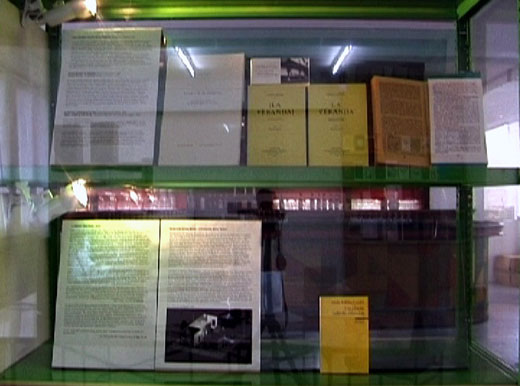
Book editions on display as part of haus.0 Print Plug-In:
Rodney Graham, Freud et le cas Katharina, Brussels: Yves Gevaert,
1991
Rodney Graham [La Véranda], Brussels: Yves Gevaert, 1989
Herman Melville, La Véranda. Brussels: Yves Gevaert, 1989
Ian Fleming, James Bond. Dr. No, General Paperbacks: Toronto, 1988
Rodney Graham, p. 56a. Dr. No, (Bookmark) New York: Christine Burgin
Gallery, 1991
Alain Robbe-Grillet, La Jalousie, Reclam Verlag, Leipzig, 1966
Constanze Ruhm
EVIDENCE (2000)
Excerpt from interview, Camera Austria
"There's a kind of collective memory of images that are familiar to everyone and suggestive of private experiences. These images spring from a commonly accessible reservoir that interests me: It supplies us with technical imagery, photography, TV, and cinema, including the stories we grew up with that were molded from them. I try to establish specific patterns and to grasp these structures both individually and superindividually at the same time. I don't see my pictures as photos of specific, subjective memory devices, but rather as that which releases them, their triggers. It's also about something like a synopsis of dispositives that arrange themselves via visual constructions. Although no one really knows these places I describe, there's still this kind of weird familiarity..."
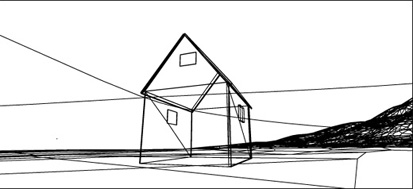
construction still, EVIDENCE, (2000) Constanze Ruhm
EVIDENCE, Constanze Ruhm
A barren place in a deserted nightly landscape. Buildings derived from recombinations of collective memories. Reconstructions of fictitious locations und images taken from the memory of media fictions and accidental arrangements that inhabit the realm of constructed imaginations. No place to visit, in fact. The buildings rather appear to be reconstructions of utopian fantasies for which there is no exchange currency. The spell is broken in the very moment in which one gets to finally see an image of something which in first place originated within language, a mischievous promise of paradise, or a SNACK, HOT MEALS, and maybe a terrace, which has no view but turns into TERROR by a simple misreading of the word itself. Evidence here is maybe only a proof for the fact that there exist collective memory reservoirs. Movie sets, locations and backdrops, pieces of scenery in a landscape which was not overtaken by sudden nightfall but which radiates an artificial darkness generated by the complete absence of light. This might be a set for a movie which will never be shot for there is no narration and no actors, but only the tale of an absence. Architecture itself becomes the lead and reflects a reality which originates in the transformation of stories into places, moments and gestures, and which is in the process of generating new fictions: a rendez-vous of forms of narrations written in collective fantasies' grammar. Images of structures of communication which have become part of a harddrive's memory are reconfigured into a different kind of syntax.
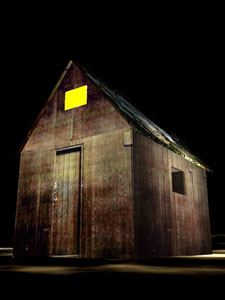
still from EVIDENCE, (2000) Constanze Ruhm
The rules of this grammar turn these visual constructions into mutual mirror surfaces. They mirror each other within the continuation of a narrative that at the same time is a recapitulation. On these models«surfaces transparent structures unfold, thus once more providing visual forms which are then coated with language. Images, counter images and terms, the topolgy and topoi as well transform into screens and sensors which orient towards each other, three-dimensional semantic surfaces.
The landscape refers to a story by Kafka. SNACK, the empty stand is derived from a 70s french movie. The cabin next to it is a digital reconstruction of a shack near Lincoln, Montana, where Ted Kaczyinski lived who became known as the UNA Bomber. After he was sent to prison, the whole cabin was declared body of evidence. It was wrapped in blue plastic and taken away on a truck to a hangar owned by the FBI, where it looked like an installation by some contemporary artist. The third building emerges from a different context. TERROR refers to a photography by Julius Shulman from 1938 which shows a movie theater in Los Angeles which was called the TERRACE THEATER. A viewer who throws but a quick glance at the picture might read TERROR instead of TERRACE. Thus an error becomes the reality of the digital image. Terrace transformed into Terror, a neon writing in the dark which promises fiction but redeems reality. The original film titles which had been on display have vanished: instead, reality is being announced: terror, the trauma which one never forgets. A cabin, a shelter as symbol, as incorporation of existential situations; projection surfaces of romantic states of delirium. EVIDENCE is about the borders of the civilised world, about the contour of matter and materials and in which way this contour becomes visible through various media formats.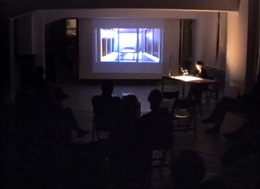
Constanze Ruhm, presentation
Künstlerhaus Stuttgart 10 / 2000